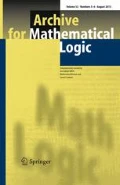Abstract
We consider whether given a simple, finite description of a group in the form of an algorithm, it is possible to algorithmically determine if the corresponding group has some specified property or not. When there is such an algorithm, we say the property is recursively recognizable within some class of descriptions. When there is not, we ask how difficult it is to detect the property in an algorithmic sense. We consider descriptions of two sorts: first, recursive presentations in terms of generators and relators, and second, algorithms for computing the group operation. For both classes of descriptions, we show that a large class of natural algebraic properties, Markov properties, are not recursively recognizable, indeed they are \(\Pi ^0_2\)-hard to detect in recursively presented groups and \(\Pi ^0_1\)-hard to detect in computable groups. These theorems suffice to give a sharp complexity measure for the detection problem of a number of typical group properties, for example, being abelian, torsion-free, orderable. Some properties, like being cyclic, nilpotent, or solvable, are much harder to detect, and we give sharp characterizations of the corresponding detection problems from a number of them. We give special attention to orderability properties, as this was a main motivation at the beginning of this project.
Similar content being viewed by others
Notes
For groups G and H and the left group action \(\rho \) of H on itself, the regular wreath product of G by H is the semidirect product \(G^H \rtimes H\) where \(G^H\) is the direct sum of |H|-many copies of G. The regular wreath product is denoted \(G \wr H\).
One can describe a bi-ordering via a Magnus expansion. To bi-order \(F_2=\langle a,b ~|~\rangle \), consider the ring of formal power series in non-commuting variables \(X_a\) and \(X_b\), \(\mathbb {Z}[X_a,X_b]\). The map induced by
$$\begin{aligned}\begin{array}{l} a \rightarrow 1+X_a \\ a^{-1} \rightarrow 1 - X_a + X_a^2 -X_a^3 +\cdots \\ b\rightarrow 1+ X_b \\ b^{-1} \rightarrow 1 - X_b + X_b^2 -X_b^3 +\cdots \end{array} \end{aligned}$$is an injective homomophism from \(F_2\) to \(\mathbb {Z}[X_a,X_b]\), the image of which is the multiplicative subgroup generated by \(F'_2=\{1+ p(X_a, X_b) ~|~\)each term in \(p(X_a, X_b)\) has degree at least 1.\(\}\). One can order \(\mathbb {Z}[X_a,X_b]\) by writing each power series in a standard form: write the terms in increasing degree, and within each degree, order the terms lexicographically according to subscripts. To compare two series, compare the coefficients of the first term on which they differ. The ordering inherited by the subgroup \(F'_2\) pulls back to an ordering on \(F_2\) via the isomorphism described above.
References
Adian, S.I.: The unsolvability of certain algorithmic problems in the theory of groups. Trudy Moskov. Mat. Obsc. 6, 231–298 (1957)
Adian, S.I.: Finitely presented groups and algorithms. Dokl. Akad. Nauk SSSR 117, 9–12 (1957)
Ash, C., Knight, J.F.: Computable Structures and the Hyperarithmetical Hierarchy. Elsevier, Amsterdam (2000)
Boone, W.W., Rogers Jr., H.: On a problem of J.H.C. Whitehead and a problem of Alonzo Church. Math. Scand. 19, 185–192 (1966)
Calvert, W., Harizanov, V.S., Knight, J.F., Miller, S.: Index sets of computable structures. Algebra Logic 45, 306–325 (2006)
Carson, J., Harizanov, V., Knight, J., Lange, K., McCoy, C., Morozov, A., Quinn, S., Safranski, C., Wallbaum, J.: Describing free groups. Trans. Am. Math. Soc. 365, 5715–5728 (2012)
Collins, D.J.: On recognising properties of groups which have solvable word problem. Arch. Math. 21, 31–39 (1970)
Dehn, M.: Über unendliche diskontinuierliche Gruppen. Math. Ann. 71, 116–144 (1911)
Dehn, M.: Transformation der Kurven auf zweiseitigen Flächen. Math. Ann. 72, 413–421 (1912)
Fuchs, L.: Note on ordered groups and rings. Fund. Math. 46, 167–174 (1958)
Fuchs, L.: Partially Ordered Algebraic Systems. Pergamon Press, London (1963)
Kopytov, V.M., Medvedev, N.Ya.: Right-Ordered Groups. Siberian School of Algebra and Logic. Consultants Bureau, New York (1996)
Lempp, S.: The computation complexity of torsion-freeness of finitely presented groups. Bull. Austr. Math. Soc. 56, 273–277 (1997)
Lockhart, J.: Decision problems in classes of group presentations with uniformly solvable word problem. Arch. Math. 37, 1–6 (1981)
Łoś, J.: On the existence of linear order in a group. Bull. Acad. Pol. Sci. 2, 21–33 (1954)
Lyndon, R.C., Schupp, P.E.: Combinatorial Group Theory. Springer, New York (2001)
Magnus, W.: Das Identitäts problem für Gruppen mit einer definierenden Relation. Math. Ann. 106, 295–307 (1932)
Magnus, W., Karrass, A., Solitar, D.: Combinatorial Group Theory. Interscience Publishers, New York (1966)
Miller III, C.F.: Decision problems for groups–survey and reflections. In: Baumslag, G., Miiler III, C.F. (eds.) Algorithms and Classification in Combinatorial Group Theory, MSRI Publications No. 23, pp. 1–59. Springer, New York (1992)
Mura, R.B., Rhemtulla, A.: Orderable Groups. Lectures in Pure and Applied Mathematics. Marcel Dekker, New York (1977)
Myasnikov, A., Romankov, V., Ushakov, A., Vershik, A.: The word and geodesic problems in free solvable groups. Trans. Am. Math. Soc. 362, 4655–4682 (2010)
Ohnishi, H.: Linear order on a group. Osaka J. Math. 4, 17–18 (1952)
Rabin, M.O.: Recursive unsolvability of group theoretic problems. Ann. Math. 67, 172–194 (1958)
Soare, R.: Recursively enumerable sets and degrees, a study of computable functions and computably generated sets. Springer, Berlin (1987)
Author information
Authors and Affiliations
Corresponding author
Additional information
Publisher's Note
Springer Nature remains neutral with regard to jurisdictional claims in published maps and institutional affiliations.
Rights and permissions
About this article
Cite this article
Bilanovic, I., Chubb, J. & Roven, S. Detecting properties from descriptions of groups. Arch. Math. Logic 59, 293–312 (2020). https://doi.org/10.1007/s00153-019-00690-x
Received:
Accepted:
Published:
Issue Date:
DOI: https://doi.org/10.1007/s00153-019-00690-x
Keywords
- Decision problems
- Combinatorial group theory
- Computability theory
- Computable model theory
- Arithmetical hierarchy
- Orderable groups


